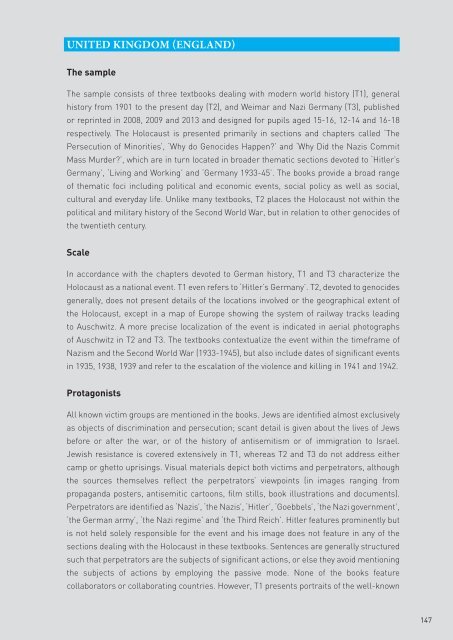228776e
228776e
228776e
You also want an ePaper? Increase the reach of your titles
YUMPU automatically turns print PDFs into web optimized ePapers that Google loves.
UNITED KINGDOM (ENGLAND)<br />
The sample<br />
The sample consists of three textbooks dealing with modern world history (T1), general<br />
history from 1901 to the present day (T2), and Weimar and Nazi Germany (T3), published<br />
or reprinted in 2008, 2009 and 2013 and designed for pupils aged 15-16, 12-14 and 16-18<br />
respectively. The Holocaust is presented primarily in sections and chapters called ‘The<br />
Persecution of Minorities’, ‘Why do Genocides Happen’ and ‘Why Did the Nazis Commit<br />
Mass Murder’, which are in turn located in broader thematic sections devoted to ‘Hitler’s<br />
Germany’, ‘Living and Working’ and ‘Germany 1933-45’. The books provide a broad range<br />
of thematic foci including political and economic events, social policy as well as social,<br />
cultural and everyday life. Unlike many textbooks, T2 places the Holocaust not within the<br />
political and military history of the Second World War, but in relation to other genocides of<br />
the twentieth century.<br />
Scale<br />
In accordance with the chapters devoted to German history, T1 and T3 characterize the<br />
Holocaust as a national event. T1 even refers to ‘Hitler’s Germany’. T2, devoted to genocides<br />
generally, does not present details of the locations involved or the geographical extent of<br />
the Holocaust, except in a map of Europe showing the system of railway tracks leading<br />
to Auschwitz. A more precise localization of the event is indicated in aerial photographs<br />
of Auschwitz in T2 and T3. The textbooks contextualize the event within the timeframe of<br />
Nazism and the Second World War (1933-1945), but also include dates of significant events<br />
in 1935, 1938, 1939 and refer to the escalation of the violence and killing in 1941 and 1942.<br />
Protagonists<br />
All known victim groups are mentioned in the books. Jews are identified almost exclusively<br />
as objects of discrimination and persecution; scant detail is given about the lives of Jews<br />
before or after the war, or of the history of antisemitism or of immigration to Israel.<br />
Jewish resistance is covered extensively in T1, whereas T2 and T3 do not address either<br />
camp or ghetto uprisings. Visual materials depict both victims and perpetrators, although<br />
the sources themselves reflect the perpetrators’ viewpoints (in images ranging from<br />
propaganda posters, antisemitic cartoons, film stills, book illustrations and documents).<br />
Perpetrators are identified as ‘Nazis’, ‘the Nazis’, ‘Hitler’, ‘Goebbels’, ‘the Nazi government’,<br />
‘the German army’, ‘the Nazi regime’ and ‘the Third Reich’. Hitler features prominently but<br />
is not held solely responsible for the event and his image does not feature in any of the<br />
sections dealing with the Holocaust in these textbooks. Sentences are generally structured<br />
such that perpetrators are the subjects of significant actions, or else they avoid mentioning<br />
the subjects of actions by employing the passive mode. None of the books feature<br />
collaborators or collaborating countries. However, T1 presents portraits of the well-known<br />
147




